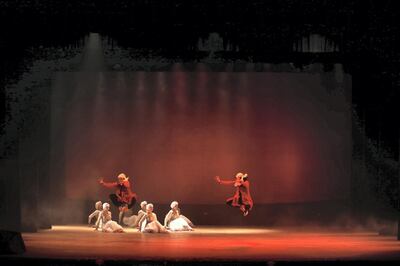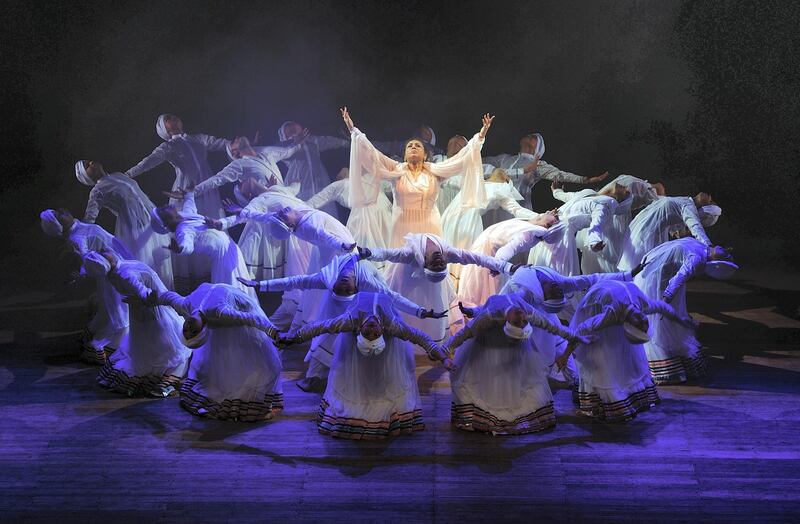Tanusree Shankar was always in love with dance. As a child, moving from city to city all over India with her father, an army doctor, she would participate in every army function involving dance, snatching opportunities to practise. But it wasn't until her father was posted to Calcutta, home to the famous Uday Shankar India Cultural Centre, that she began her formal training, studying under the famous dancer and choreographer's wife, Amala Shankar. When she married their son, composer Ananda Shankar, dance became her life.
“Usually when you get married your dance or your other extracurricular activities take a back seat, but for me it was the other way around,” she recalls. “The moment I got married into this family of the Shankars – Ravi Shankar and Lakshmi Shankar and Uday Shankar and Amala Shankar – I was constantly performing and dancing and teaching.
“That’s how the whole profession sort of fell into my lap – and I was really enjoying every moment of it.”
'A spiritual journey'
Now an acclaimed choreographer and accomplished dancer, Tanusree brings her latest performance, We the Living, to the Emirates Palace Auditorium today, part of the 15th Abu Dhabi Festival and upholding India's role as this year's Country of Honour.
An interpretation of Persian Sufi poet Jelaluddin Rumi's poem Human Being – often entitled Only Breath in English translation – We the Living envisages humans as beings that have transcended culture, caste and creed, and even their own physical forms, to reach a higher spiritual plane.
Tanusree was moved by Rumi's work after a friend gave her a book of his poetry after a performance in the United States. "I came across this fantastic poem and it really inspired me and made me feel that it was something so relevant in today's time," she says.
“The poem is about seeing humanity as the only religion. It’s about breathing or surrendering to a common power or a common light, which guides you. It’s very universal and I always work on universal themes.”
Set to music by well-known Indian film composer Debojyoti Mishra, she describes We the Living as "a spiritual journey", which evokes the progression of the human being from its raw physical state to a higher consciousness on stage.
“Our show starts from the human body, which is shapeless, and from there the birth of the body where we come to a shape and we get our five senses. Then we get our emotions – we get sorrow, we get jealousy, we get happiness,” she says.
Tanusree blends Rumi's Sufi philosophy with the ancient Sanskrit concept of the rasa – meaning "juice", or "essence. Dating back thousands of years, rasas are emotional states experienced by the audience during a performance. Like Rumi's poetry, classical Indian performing arts use rasas to evoke emotion and provoke reflection on spiritual and moral questions.
“All these emotions are given to us and then we go out and search to find our identity,” Tanusree says. “The poem says, ‘I’m not from the ocean, I’m not from the sky.’ So it’s about finding your own identity, and following that search we realise that what we are searching for is within us … Once we realise that, we surrender to that power, which has allowed us to realise this. This is how I have interpreted the poem.”

Modernism's pioneer
Tanusree's father-in-law, Uday Shankar, is known as the pioneer of modern dance in India. Born in Rajasthan in 1900, he trained at the J J School of Art in Mumbai and later travelled to London, where his father was living, to study at the Royal College of Art. Although his father was a barrister, Uday came from an artistic family – his younger brother Ravi Shankar would go on to become a master sitar player, perhaps the best-known classical Indian musician in the world.
Although he had no formal training, Uday had been exposed to Indian classical and folk dance and to European ballet. He decided to bring elements of both together to create a new form, dancing at several charity performances organised by his father. At one of these events he met the famous Russian ballerina Anna Pavlova, beginning a friendship that was to have an effect on both their careers.
"He worked with her and he choreographed two pieces for her, The Hindu Wedding and Radha-Krishna," Tanusree says. Their collaborative performances were presented at high-profile venues, including the Royal Opera House in London, in the 1920s.
After a stint in Paris, where he founded Europe’s first Indian dance company, and a seven-year tour of Europe and America, he returned to India in 1938. He married his dance partner, Ananda Shankar, with whom he founded his dance school in Calcutta. They had two children, a daughter, Mamata Shankar, today a dancer and choreographer, and a son, Ananda Shankar, a prominent composer who later married Tanusree.
"My husband was an extremely encouraging person and he always motivated me to do something very innovative," she says. "He was a composer, so most of the music used to be written by him until he passed away in 1999. Since then, I have been working with other composers but before that I used to mainly work with him. That's how my whole journey started as a choreographer."
We the Living will be preceded by three short dances, including a welcome dance to music composed by Ananda, she says. The performance is choreographed in what Tanusree calls "the Uday Shankar style".
“It has the essence of all the Indian classical dances and traditional dances but it’s not absolutely pure.What you see is very much innovative and improvised. It’s a very modern approach,” says Tanusree, who studied classical Indian dance forms including Bharatanatyam, Manipuri and Kathak, alongside the Uday Shankar style.
"In my productions I always try to do something a little different, in the sense that I always believe in positivity, so all my work is not trying to preach but it's trying to give the audience an awareness of certain ideas," she says.In keeping with the universal theme, Tanusree has set the performance to a complex score, including several translations of Rumi's poem.
"Victor Banerjee, a very well-known actor who was in Passage to India and all these films, has read the English poem, and there is a Persian version as well and then there are a few songs, which are in Maithili language, which talk about the five senses," she says. "There are two beautiful songs by Shubha Mudgal and Shafqat Amanat Ali, who have sung the Sufi songs."
Played on classical Indian instruments, the music is a fitting backdrop to the fusion spirit of the performance.
“The music is very innovative, just like the dance. We have tried to stick to Sufism and we have also tried to create the feel of the search where you’re looking for different religions, just through music and effects,” she says. “It ends with a beautiful song in Sanskrit that talks about the whole world being one. We all have the same breath and the same sky.”
We the Living is at Emirates Palace Auditorium on Monday at 8pm. For information and tickets, visit www.abudhabifestival.ae
_______________
Read more:
Omar Kamal: The jazz man who flew to the moon
[ 47Soul on album Balfron Promise and using a theme of displacement in their music ]
Emirati composer Ihab Darwish on the very personal story behind 'Waves of My Life
Eurovision-style Russian music awards Bravo to be held in Abu Dhabi this year
_______________





